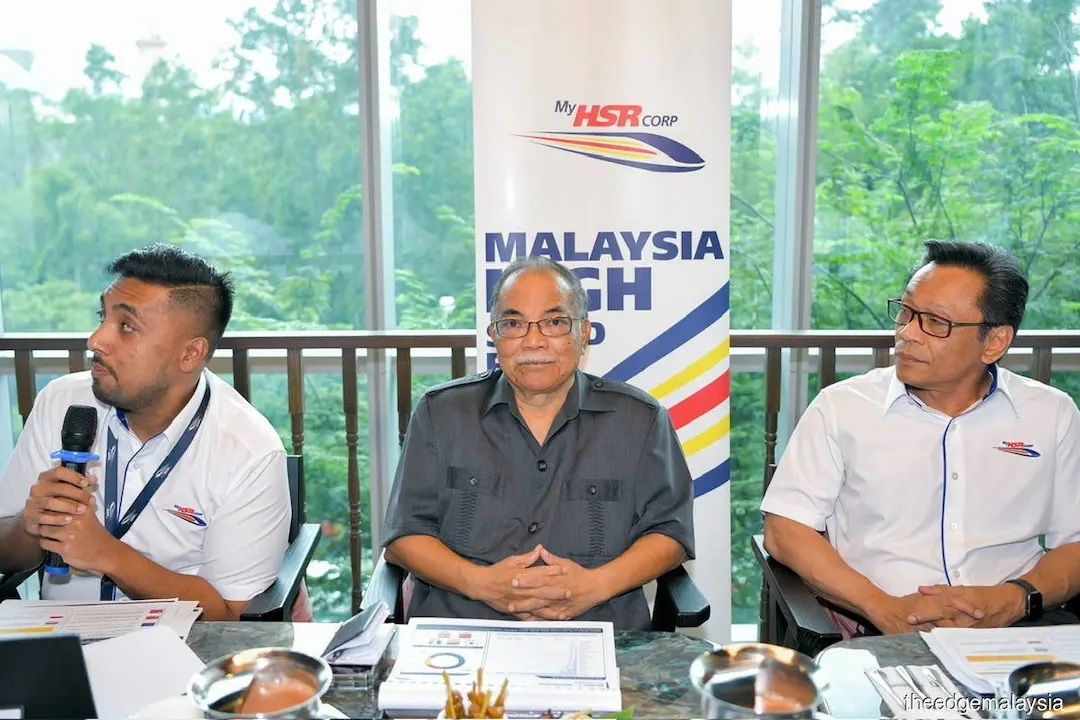
- “So far, the response has been positive. But they (the interested parties) need more details from us (MyHSR), and that is only available in the RFI document, which will be issued later — after a briefing session fixed to be held on July 27," said MyHSR chief executive officer Datuk Mohd Nur Ismal Mohamed Kamal.
KUALA LUMPUR (July 12): Given the hefty debt on the government's shoulders, the revived Kuala Lumpur-Singapore High-Speed Rail (KL-SG HSR) project is expected to be fully funded and driven by the private sector, according to MyHSR Corp Sdn Bhd.
During a media briefing on Wednesday (July 12), MyHSR chairman Datuk Seri Fauzi Abdul Rahman said the agency's request for information (RFI) for the project — open to both local and international players — is to test the waters of the private sector’s reception to bearing the project's full financial risks.
“So far, the response has been positive. But they (the interested parties) need more details from us (MyHSR), and that is only available in the RFI document, which will be issued later — after a briefing session fixed to be held on July 27," said MyHSR chief executive officer Datuk Mohd Nur Ismal Mohamed Kamal.
“That will provide a better picture for them to evaluate if it (the HSR) is a viable business going forward,” he added.
MyHSR head of commercial and economy Mohd Ikhsan Ahmad noted that no other HSR developments had ever been fully funded by the private sector — with the closest being the Taiwan High Speed Rail linking Taipei and Kaohsiung, where 79% was funded by the private sector.
Most HSR developments were fully public-led, he said, while seven were developed via the public-private partnership approach.
"However, Malaysia aims to develop the KL-SG HSR project without government funding and guarantee," Mohd Ikhsan said, adding that it will be undertaken via a design, fund, build, operate and transfer model.
As the project is now expected to be fully privately funded, Mohd Nur said most of the project’s details — including the imported HSR technology utilised, the alignment, costs, stations, and the concession period — are still up in the air, as industry players have free rein to propose changes to the project’s initial plan.
Prior to being terminated in January 2021 during Tan Sri Muhyiddin Yassin’s premiership, the HSR was envisioned to stretch 350km with seven stations, and targeted to be completed in 2026 with a projected cost of RM110 billion.
Besides surveying industry players' reception, Mohd Ikhsan said the non-binding RFI is aimed at assessing the readiness and capabilities of industry players, as well as to gather business model and funding ideas.
In this nascent stage of the project, he said MyCorp will be looking at each concept proposal’s vision and strategy, technical and commercial aspects, project cost, as well as consortium structure.
Subsequently, the shortlisted consortia will advance to the binding request for proposal (RFP) stage, where each will be required to conduct a detailed feasibility study to be incorporated into a final proposal.
On conclusion of the RFP stage, where a preferred bidder is selected, government-to-government (G2G) negotiations with Singapore will take place, said Mohd Nur Ismal.
To shore up Malaysia's competitiveness for foreign investments
On why the government is revisiting the KL-SG HSR project, Mohd Nur Ismal pointed to the projected economic benefits Malaysia is set to reap from the mega infrastructure project, as well as the shoring up of the nation's capabilities to compete with regional peers for foreign investments.
Based on MyHSR's projections done on the original KL-SG HSR alignment, the project is expected to contribute RM252 billion in direct development output, RM145 billion from international tourism, and 1.01 million employment opportunities over a 60-year period ― 10 years during construction, and the subsequent 50 years under the operating phase.
Mohd Nur Ismal also highlighted that many of Malaysia’s closest neighbours — Thailand, Vietnam and Indonesia — have all planned HSRs as part of their respective targets to position themselves as key global investment destinations.
“We (MyHSR) have a pretty big agenda to drive; it's about changing Malaysia as a country, as a society — how we compete with the rest of the world, and how we structure the economy,” he added.
On economic viability, Mohd Ikhsan said the HSR project must be driven by a plan which integrates economic clusters along its alignment, citing Taiwan’s HSR — which locates its stations in key economic clusters — as a key example.
This economic integration is another aspect that MyHSR and the government will be keenly assessing when looking at interested parties’ proposals.
As for commercial viability, Mohd Ikhsan noted that based on 10 HSR operators globally that publish their financial results, nine are “commercially viable at the earnings before interest, taxes, depreciation, and amortisation (Ebitda) level”.
In March this year, The Edge Malaysia weekly reported that the federal government had held meetings with five Malaysian companies to gauge their interest in pursuing the HSR project.
According to the report dated March 27-April 2, the five were: Tan Sri Syed Mokhtar Albukhary-controlled MMC Corp Bhd; WCT Holdings Bhd, controlled by Tan Sri Desmond Lim Siew Choon; YTL Group; Tan Sri Vincent Tan Chee Yioun-controlled Berjaya Group; and Malaysian Resources Corp Bhd (MRCB).
In a follow-up report for the week of May 8-May 14, the weekly wrote that at least two of the five companies were having high-level discussions for a potential partnership with Chinese state-owned enterprises, while one appeared inclined to partner with a Japanese consortium. The remaining two were said to be waiting for the government to reveal more information on the project.





